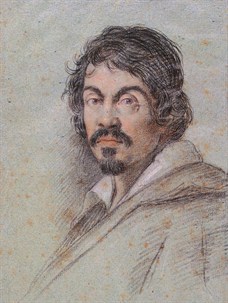Michelangelo Merisi, known as Caravaggio
 Michelangelo Merisi, known as Caravaggio (1571-1610) was one of the greatest figures in the history of international art. Born in Milan, he came to Rome in 1592-1593, finding in Cardinal Francesco Maria del Monte his first powerful protector. He worked for the most important Roman families, such as the Giustiniani, the Barberini, the Borghese, the Mattei and the Patrizi, as well as in several churches. After making killing someone on 29 May, 1606, Caravaggio left Rome and took refuge in the following years in Naples, Malta, Sicily and back to Naples. He died of pneumonia or dysentery on 18 July 1610, just when there was a rumour that the pope was ready to forgive him for killing a Roman. Many of the works of Caravaggio have a worldwide reputation and are at the summit of European art of the sixteenth and seventeenth centuries, especially through masterful use of light. Some examples: The Calling of Saint Matthew, Crucifixion of Saint Peter, the Deposition, The Basket of Fruit, Bacchus, The Supper at Emmaus, The Martyrdom of Saint Ursula, David with the Head of Goliath, The Seven Acts of Mercy, The Flagellation of Christ, Amor vincit Omnia, The Conversion of Saint Paul, Judith beheading Holofernes.
Michelangelo Merisi, known as Caravaggio (1571-1610) was one of the greatest figures in the history of international art. Born in Milan, he came to Rome in 1592-1593, finding in Cardinal Francesco Maria del Monte his first powerful protector. He worked for the most important Roman families, such as the Giustiniani, the Barberini, the Borghese, the Mattei and the Patrizi, as well as in several churches. After making killing someone on 29 May, 1606, Caravaggio left Rome and took refuge in the following years in Naples, Malta, Sicily and back to Naples. He died of pneumonia or dysentery on 18 July 1610, just when there was a rumour that the pope was ready to forgive him for killing a Roman. Many of the works of Caravaggio have a worldwide reputation and are at the summit of European art of the sixteenth and seventeenth centuries, especially through masterful use of light. Some examples: The Calling of Saint Matthew, Crucifixion of Saint Peter, the Deposition, The Basket of Fruit, Bacchus, The Supper at Emmaus, The Martyrdom of Saint Ursula, David with the Head of Goliath, The Seven Acts of Mercy, The Flagellation of Christ, Amor vincit Omnia, The Conversion of Saint Paul, Judith beheading Holofernes.
